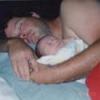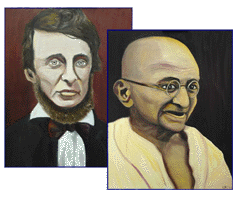"The whole aim of practical politics is to keep the populace alarmed (and hence clamorous to be led to safety) by menacing it with an endless series of hobgoblins, all of them imaginary." ~ H.L. Mencken
Thoughts on Race, Enclaves and Kicking Sleeping Dogs
About a month ago I started a thread on my favorite internet discussion forum about what it feels like to live in a society that diminishes and discounts your personhood if you are not a member of the majority race. Oh my! The reaction!
It was interesting the way that the responses broke down. Most who are not white males viewed my observations as a breath of fresh air. Someone finally admitted to the presence of the big pink elephant in the room that everyone knew was there but had trepidation about mentioning. The posters who were self-identified as female and/or racial or ethnic minorities agreed that American society gives advantages and breaks to white males and those who can pass for white males, and 'disadvantages' (to say the least), to those who are not.
In complete contrast were the reactions of the self-identified white males. Some said that as the majority population, they admittedly gained some small, minor advantages, but not much. They went on to say what a whiner I am to complain about it and I should just accept it and get over it. Get on with my life. Some denied any advantages accrued at all to being a white male and further claimed it was they who were the ones being discriminated against. Nope, they said this advantage you claim doesn't exist at all. Nope, no way, zilch and da nada. We just don't see this as a problem. And so there things stand.
But the purpose of this essay isn't to examine that issue. I've included it here to serve as an introduction as to why I believe that large, multi-racial, ethnically mixed, mega-States are becoming more likely to crack, crumble and fall as ruling societal entities. I believe that self-selected affinity grouped enclaves are what will replace them. And that this replacement process has already begun. And that this is the action that should be taken by those of us who can't or won't countenance the continued sense and condition of apartness in which the dominant majority holds us.
As is widely recognized, San Francisco , California has a large and active gay and lesbian population. So does Key West , Florida . Gays are unique among affinity groups in that they span the gamut of genders, races, national origins and ethnicities. They appear in all population groups and aren't native to any specific region, group or locale. Despite the loosening of societal norms and greater social acceptance, homosexuals are still stigmatized and discriminated against to a very large degree. They share a generalized sense of apartness and anomie toward the dominant culture.
And so, wanting the acceptance of their lifestyles and the company of their fellows, they left other places throughout the US and the world and gathered themselves together in places like Key West and San Francisco . Places where eventually their sheer numbers alone brought about their inclusion into a powerful position in local politics, and their opinions matter. They exist in these two cities amongst others, in numbers too big to be ignored (Adler & Brenner 24).
Cultural institutions, community events and commercial enterprises have emerged in these enclaves that are specifically run by or cater to the preferences and tastes of the gay and lesbian communities. Many have become viable, profitable businesses and institutions. And these businesses and cultural institutions give a sense of permanence and stability to the communities that they serve that further enhances the vitality of the gay and lesbian enclaves that support them in return (Adler & Brenner 31).
There is nothing new about this phenomenon of forming enclaves of like-minded or ethnically related peoples. The origins of many of the European settlements in North America in the 17th Century were religious denominations that wished to practice their faith free of the discrimination, harassment and violence that they encounter in the European states that were dominated by State-sanctioned religions (Shipps 43).
Later on in the 1830s, the newly formed Church of Jesus Christ of Latter-Day Saints, (Mormons) faced with hostility, discrimination and violence, left New York state and relocated to Illinois and then to Utah. From 1839 to 1850, they had their own sovereign nation, Deseret, which endured until Utah was occupied by the US Army and annexed as a territory of the US in 1850 (Shipps 56).
Racial and ethnic minorities who were heavily discriminated against and harassed often formed their own enclaves in cities where they could protect and cater to their own kind and establish themselves. Chinatown , Little Italy, and Germantown , Harlem and Spanish Harlem, and South Boston are examples of this enclavism from the 19th and early 20th centuries where newly immigrated people went to gain safety and the ability to survive and endure in a new land (Briseno 168-9).
Miami 's Little Havana enclave of Cuban immigrants and exiles is an example of how this trend is with us today. Little Havana was formed in the 1960s and is an ongoing collective response by people to provide protection from a hostile and unaccepting culture. Enclaves serve to enhance the prospects for viability and entry into the local governing political institutions, and to gain and preserve autonomy and independence of action for an immigrant or exile community (Briseno 166-7).
Enclaves can and do fail, if they are sufficiently threatening to the majority community or they make aggressive and violent moves against neighboring communities. The Aryan Nations enclave in Hayden Lake , Idaho was dispersed and eliminated when it was dispossessed of its property as the result of a judgment won against them. Members of the Aryan Nations community attacked, threatened, and injured local people who successfully sued the white ethno-nationalist community and were awarded the Aryan Nation's property as compensation.
The Branch Davidian Church enclave in Waco , Texas was attacked by agencies of the US government for vague and dubious reasons in early 1993. The Davidians resisted this action with armed force of their own, resulting in the injury and death of both officers and Davidians. This attempt at self-defense led to a prolonged siege of the Davidian homestead by US government police agencies and US Army troops lasting 51 days. The enclave was finally destroyed by a Masada-like final attack on them that resulted in the total destruction of the homestead, 84 additional Davidian deaths and the prosecution and imprisonment of the surviving members.
Why the federal government singled out this enclave for a Warsaw Ghetto-style extermination action is not entirely clear, and may never be. But it does serve as a reminder of the need to evolve deliberately and peacefully to the greatest extent possible. Armed action against neighbors or the US or local governments has always proved to be a futile if understandable reaction by people to attacks by anyone on their homes and family groups.
And yet enclaves are and continue to be the best response to founding a community that can endure and flourish based on its own vision of group affinity and their collective idea of how life should be lived. I believe it is a viable and necessary response by those of us who reject or are ourselves marginalized and rejected by the larger and more powerful majority culture and its ruling apparatus, or at least the best response that is likely to actually work.
The Amish, Mennonite and Native American Nations, to name but a few, are enclaves that have endured and survived while keeping true to their founding principles. They deserve closer examination and scrutiny by those of us who seek to form social arrangements where we can be free to live our lives in accordance with the principles we believe in and made up of companions that we've chosen and have chosen us.
Sources Cited
Adler, S. and Brenner, J. Gender and Space: Lesbians and Gay Men in the City. International Journal of Urban and Regional Research. 1992.16: 24-34.
Briseno. Brad G. Little Havana ' Portrait of a Community. Los Angeles : Farnam Press. 1999.
Shipps, Jon. The Quakers, Mennonites, Amish and Mormons: Independent Religious Communities in America . New York : Daulder Press. 1984.








 Reprint Rights
Reprint Rights